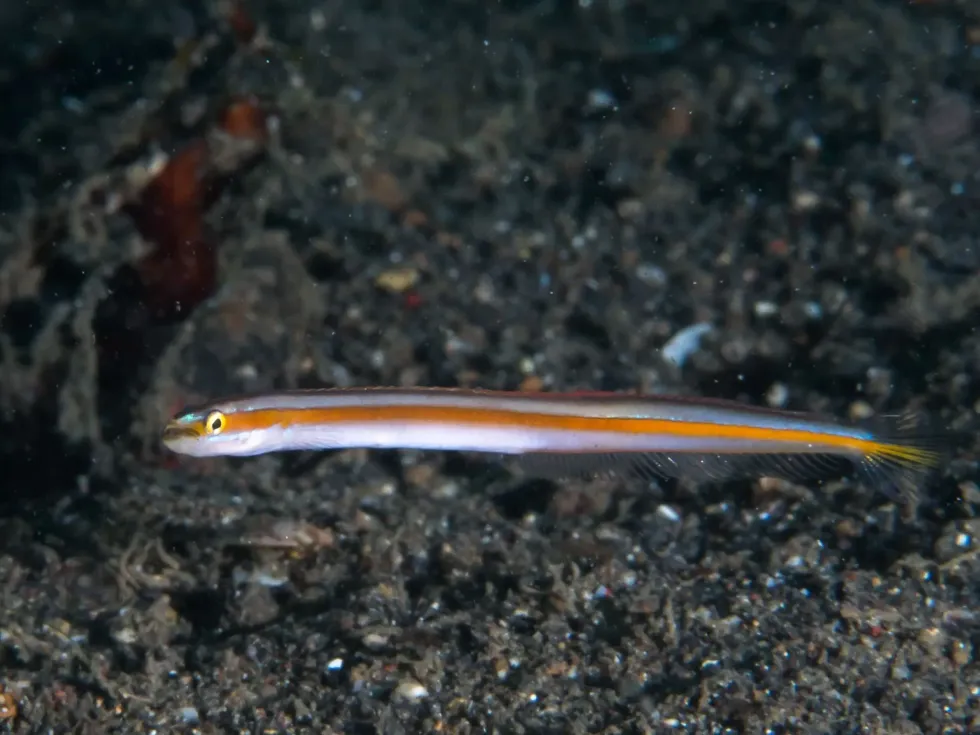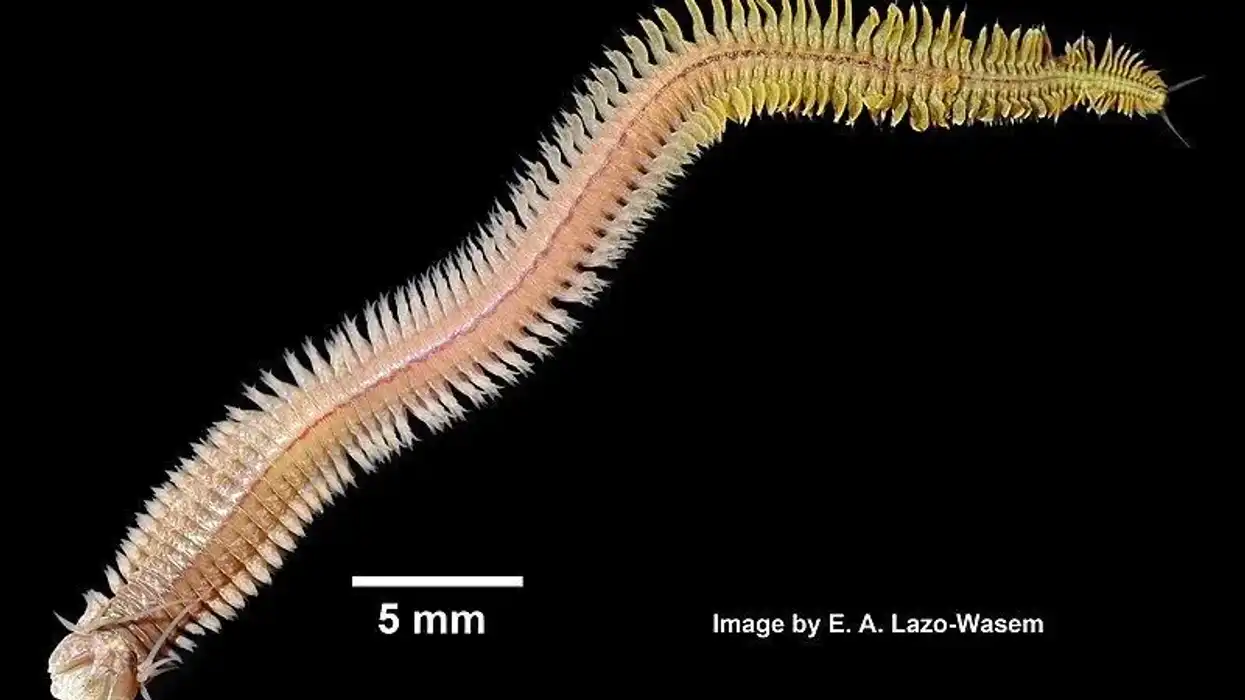The curious wormfish is a unique and intriguing reef fish possessing an extended eel-like body with longitudinal orange and blue stripes. They are susceptible to low water quality as well as handling and transportation stress.
Keep this species in a 30 gal (136.3 L) aquarium with a fine sandy substrate for burrowing at night. The tank must have a tight-fitting lid with no gaps, as leaping is the most common cause of death in captivity for curious wormfish. They're enigmatic, and they're difficult to feed, so give them meaty meals such as Mysis shrimp.
To attract picky eaters, use enhanced live adult brine shrimp. Choose tank mates that are tiny and calm and will not hurt or frighten them.
You might also love to read about rainbow trouts and pumpkinseed sunfish.
Curious Wormfish Interesting Facts
What type of animal is a curious wormfish?
The Gunnelichthys curiosus is a type of wormfish.
What class of animal does a curious wormfish belong to?
The curious wormfish belongs to the class Actinopterygii.
How many curious wormfishes are there in the world?
This species' population data is unknown at present.
Where does a curious wormfish live?
Gunnellichthys curiosus is a wormfish endemic to the Indian Ocean, ranging from the Seychelles and Mauritius to the Hawaiian Islands in the central Pacific. It lives in regions with substrates that allow it to hide in burrows.
What is a curious wormfish's habitat?
It prefers sandy and muddy bottoms and seeks safety in burrows when threatened. It is found at depths ranging from 30-197 ft (9-60 m).
Who do curious wormfish live with?
Gunnelichthys curiosus can be kept up in small groups but these fish are even timider than seahorses, and should not be housed with swimming fish, like wrasses. Almost any fish will readily outcompete and harass them for food.
They are very thin and the smallest, most tranquil fish can readily consume them. Giant groupers, dottybacks, triggerfishes, and aggressive angelfishes should not be kept with them.
How long does a curious wormfish live?
They have a low survival rate in captivity, owing primarily to inadequate shelter.
How do they reproduce?
Reproduction in fishes differs depending on the species, but it typically occurs in one of three ways. In most situations, the female deposits eggs in the water, which are promptly fertilized by the male's sperm.
Another method is for fertilization to occur within the female's body prior to dropping the eggs into the water. The mother keeps the eggs within her stomach in the third and final way, and the young are born alive.
What is their conservation status?
This fish species is classified as of Least Concern.
Curious Wormfish Fun Facts
What do curious wormfish look like?

The rainbow goby, neon worm goby fish, and yellow-striped worm eel are all names for the Gunnelichthys curiosus. The curious wormfish is distinguished by orange and metallic blue stripes that span the length of its body.
How cute are they?
The curious fish is a unique and captivating reef fish with a broad orange-blue stripe running down the side of the head and body, terminating in a huge black blotch at the tail base. It is a really unusual and adorable fish that would make an excellent addition to an aquarium if kept as a pet.
How do they communicate?
Fish have long been known to communicate through a variety of quiet techniques, but researchers have now discovered evidence that certain species also utilize sound. The highly controlled synchronized swimming of schools of fish demonstrates how fish communicate through gesture and motion.
Some species utilize electrical pulses as signals, whereas others, such as the firefly, use bioluminescence. Some fish also emit compounds that can be detected by smell or taste.
How big is a curious wormfish?
Wormfishes are small fishes. The largest know wormfish that is the Gunnelichthys curiosus is about 4.7 in (12 cm) in length.
How fast can a curious wormfish swim?
Fish swimming speed is governed by their form, size, and structure. Furthermore, fish usually cruise at a different speed than their maximal attack speed. Gunnellichthys curious is known to be a fast-swimming fish.
How much does a curious wormfish weigh?
There isn't enough information on these fishes about their size and weight.
What are the male and female names of the species?
The males and females don't have separate names.
What would you call a baby curious wormfish?
When a baby fish is able to feed itself, it is referred to as fry. When a baby fish develops fins and scales, it is considered fingerling.
What do they eat?
Worm fishes' diet includes benthic crustaceans and zooplankton. A meaty diet is required, including enriched shrimp, Mysis, and other meaty types of marine fresh or frozen meals, which should be finely diced and dispensed upstream so the water current may deliver the food to the region it resides.
Two feedings each day are required. If feeding is difficult at first, try some live meals, such as adult supplemented brine shrimp.
Are they poisonous?
Gunnellichthys curiosus are known to be harmless to humans.
Would they make a good pet?
Species in this group require more care as well as better water quality. Many of these species have specific requirements for food(shrimp), water quality, mobility, and illumination.
They should only be added to a mature, well-established aquarium system, especially corals and delicate invertebrates because many reef aquariums do not become completely established for months, if not a year.
These 'difficult' species should be the last to be added to your collection.
A tank of at least 30 gal (136.3 l) or bigger with a sandy bottom will offer a healthy environment for this fish, which likes to burrow in the soft substrate at night and when disturbed.
Curious wormfish may be kept as an individual or in small groups, but they must all be introduced to the tank at the same time and have enough swimming space.
Because it is easy prey for more aggressive marine animals, its tank mates should be tranquil. These fish must be housed in an aquarium with a secure lid.
The neon worm goby is so tiny that it can fit through even the smallest of openings.
Did you know...
A hardy fish is any fish that can adapt to a wide variety of marine parameters and is thus simple to keep in a home aquarium/tank. Such fish make excellent starters and are great for 'cycling' an aquarium/tank, which means decreasing ammonia and nitrites to near-zero levels. Gunnellichthys curiosus may also be classified as hardy fishes.
Are curious wormfish endemic?
The Gunnellichthys curiosus is a species of wormfish that is endemic to the Indian Ocean. Although it is also available in the aquarium (tank) trade.
Is the curious wormfish a reef fish?
Gunnellichthys curious come under reef fishes. Reef fish are the fish that dwell on, around, or within coral reefs.
Coral reefs are complex ecosystems with a high level of biodiversity. Among the numerous residents, it stands out as colorful and entertaining to observe.
Hundreds of species can coexist in a short area of a healthy reef, many of which are concealed or well disguised. Reef fish have evolved a plethora of clever specializations in order to survive on the reefs.
Coral reefs cover less than 1% of the surface area of the world's seas, yet they are home to 25% of all marine species. Reef ecosystems stand in stark contrast to the open water habitats that comprise the remaining 99 % of the world's seas.
Here at Kidadl, we have carefully created lots of interesting family-friendly animal facts for everyone to discover! For more relatable content, check out these kelp rockfish facts and giant guitarfish facts for kids.
You can even occupy yourself at home by coloring in one of our free printable curious wormfish coloring pages.










